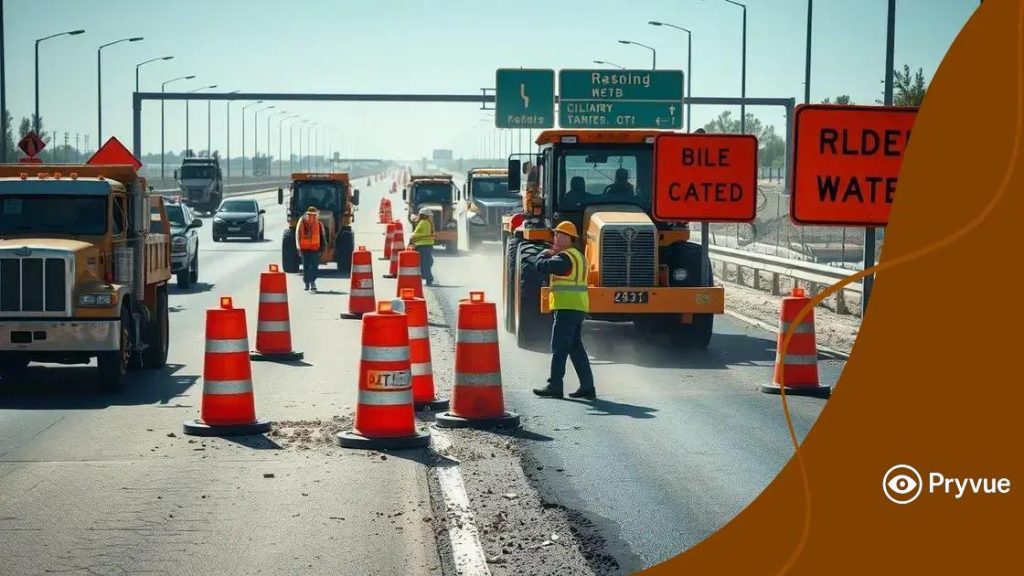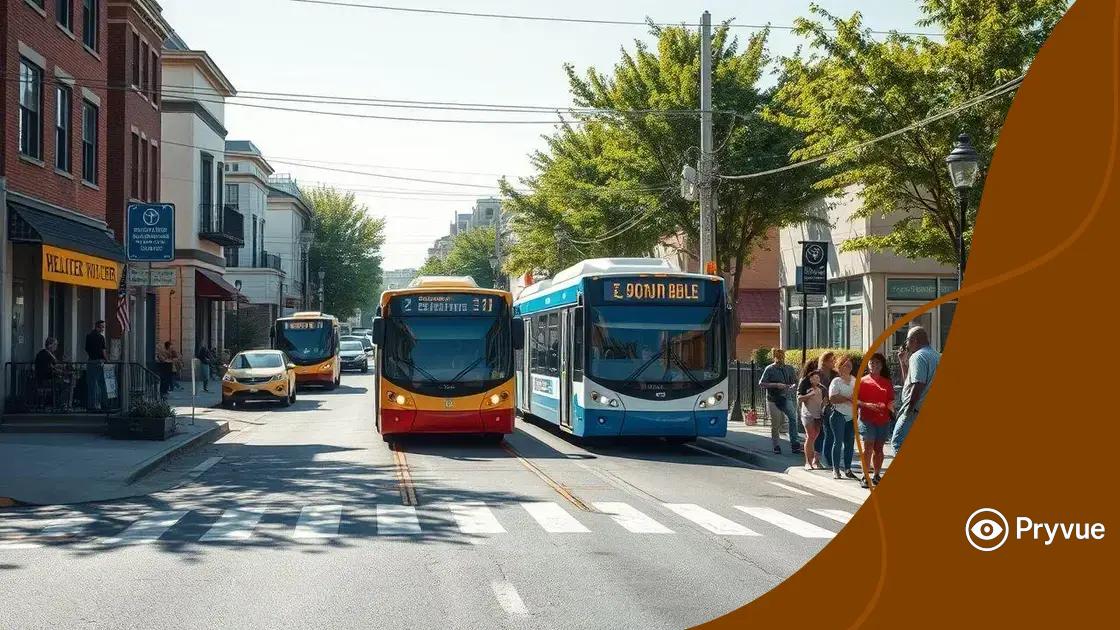Updates on American infrastructure work: what you need to know

Anúncios
Updates on American infrastructure work highlight key challenges like funding shortages and regulatory hurdles, while emphasizing the need for community engagement and innovative solutions to create sustainable and efficient systems.
Updates on American infrastructure work are crucial as they reveal how our roads, bridges, and public systems are evolving. Are you curious about the projects that might be impacting your daily commute or community? Let’s dive into what’s happening.
Anúncios
Current status of infrastructure projects
The current status of infrastructure projects across America is a hot topic, drawing attention from legislators, local communities, and businesses alike. Understanding where we stand helps us grasp the improvements being made and the challenges ahead.
Major Projects Underway
Several major infrastructure projects are currently in progress. These efforts aim to revitalize aging facilities and enhance transportation networks. Notably, the significant projects include:
- Highway expansion projects to reduce congestion.
- Bridge renovations for added safety.
- Public transit upgrades to improve accessibility.
- Water system improvements for cleaner supply.
While these projects are essential for modernizing our infrastructure, they also involve considerable funding and time commitments. Each project varies in scope and timeline, impacting when communities can expect improvements.
Anúncios
Funding and Support
Funding remains a critical aspect of the current infrastructure landscape. The government has allocated budgetary support to facilitate these major projects. However, the reliance on federal funds can sometimes delay progress, as discussions over financing continue.
On a local level, community advocates are actively supporting initiatives that aim to prioritize infrastructure development. Identifying suitable challenges and opportunities is vital for successful project implementation.
Moreover, the collaboration between public and private sectors ensures that projects align with community needs. This cooperative approach helps drive timely execution, ultimately benefiting everyday Americans who depend on improved infrastructure.
Funding sources for infrastructure improvements
Understanding the funding sources for infrastructure improvements is essential to grasp how projects come to life. Many different avenues provide financial support for these critical developments.
Government Funding
Government funding plays a prominent role in infrastructure projects. Federal, state, and local governments allocate budgets specifically for construction and upgrades. Each level has unique responsibilities and regulations governing the distribution of these funds.
- Federal grants that support large-scale projects.
- State funds determined by local budgets and priorities.
- Municipal bonds used for community-specific projects.
- Infrastructure improvement programs focused on key areas like transportation and utilities.
This multi-tiered approach allows various initiatives to receive necessary backing, ensuring that communities can move forward with important upgrades.
Private Investments and Partnerships
In addition to government funding, private investments play a crucial role in enhancing infrastructure. Public-private partnerships (P3) have become increasingly popular over recent years. These collaborations enable private entities to finance projects in exchange for future revenues.
Such partnerships can expedite project timelines and reduce the financial burden on taxpayers. They can result in innovative solutions and approaches to infrastructure development, fostering a shared interest in community growth.
Moreover, banks and financial institutions also invest in infrastructure improvements, providing loans and other financial instruments to support the development of critical projects. This diverse mix of funding sources is vital, ensuring that infrastructure improvements are not just a possibility but a reality for many communities.
Impact of infrastructure updates on local communities

The impact of infrastructure updates on local communities is profound and far-reaching. These improvements often lead to enhanced quality of life for residents.
Economic Growth
First and foremost, updated infrastructure can boost local economies. When roads are repaired and public transport systems are modernized, it attracts businesses and stimulates job creation. With better infrastructure, companies are more likely to invest in an area, knowing their employees can commute easily.
- Increased accessibility for customers and suppliers.
- Creation of new jobs in construction and maintenance.
- Attraction of new businesses and investment.
- Enhanced property values in the vicinity.
This economic rejuvenation can help lift an entire community, providing more opportunities for families to thrive.
Increased Safety and Accessibility
Another significant benefit of infrastructure updates is the increase in safety for all community members. Modernized roads with better signage, lighting, and sidewalks reduce accident rates. Public spaces become more accessible for everyone, including individuals with disabilities.
Moreover, updated water systems and improved waste management produce healthier living conditions. Communities feel safer and more comfortable, encouraging residents to engage in local activities and events.
Improved infrastructure also allows for better emergency response capabilities. Roads and bridges designed to withstand natural disasters ensure faster access for first responders, minimizing potential harm during emergencies.
Future trends in American infrastructure
The future trends in American infrastructure are shaping the way we think about public works and community planning. As technology evolves, so do our approaches to developing infrastructure that meets the needs of growing populations.
Smart Cities
One key trend is the rise of smart cities. These urban areas leverage technology to improve efficiency and quality of life. Smart infrastructure includes:
- Connected transportation systems that reduce traffic congestion.
- Energy-efficient buildings that lower utility costs.
- Data-driven public services that respond to community needs.
- Sensors and IoT devices that provide real-time information.
These innovations enhance the daily lives of residents, making cities more sustainable and responsive.
Green Infrastructure
Another important trend is the focus on green infrastructure. This approach emphasizes the integration of natural systems into urban planning. By prioritizing environmentally friendly solutions, cities can address stormwater management and air quality issues effectively.
Some examples of green infrastructure include:
- Green roofs that reduce heat and improve energy efficiency.
- Permeable pavements that allow water to filter through.
- Urban forests that enhance air quality and provide shade.
- Community gardens that promote local food production.
As cities adopt these eco-friendly practices, they not only improve urban resilience but also create healthier living environments.
Lastly, the integration of renewable energy sources like solar and wind into infrastructure is becoming crucial. This shift supports a transition toward sustainable cities and reduces dependence on fossil fuels.
Challenges facing infrastructure development
Infrastructure development in America faces several significant challenges that can hinder progress. These issues require attention to ensure that projects run smoothly and effectively meet community needs.
Funding Limitations
One of the biggest hurdles is securing adequate funding. Many infrastructure projects rely on government budgets, which can be tight or inconsistent. Without enough funding, projects may experience delays or get canceled altogether.
- Government budgets are often stretched thin.
- Rising costs for materials and labor reduce the number of viable projects.
- Funding competition between different sectors leads to prioritization issues.
- Long approval times for financial backing delay project starts.
These factors can slow the pace of necessary improvements in infrastructure, affecting the lives of residents.
Regulatory Challenges
Another hurdle in infrastructure development involves navigating complex regulations. Local, state, and federal guidelines can create a maze for project managers to work through.
These regulations can hold up projects due to:
- Lengthy permitting processes.
- Environmental impact assessments that require substantial resources.
- Public hearings and community feedback loops that can prolong timelines.
- Compliance with various local ordinances and federal laws.
These obstacles can extend the time needed to complete projects, making it difficult to keep up with local infrastructure needs.
Additionally, community opposition can further complicate developments. Residents may resist changes due to concerns over environmental impacts, displacement, or aesthetics.
Through understanding these challenges, stakeholders can better prepare and respond to the obstacles in developing and maintaining a modern infrastructure system.
In summary, the evolution of American infrastructure is crucial for our communities. By addressing current challenges such as funding shortages and regulatory hurdles, we can foster long-term benefits. Embracing innovative technology and sustainable practices will help us build a brighter future. As we move forward, it is essential to keep local communities engaged in the planning process. Together, we can create infrastructure that meets the needs of everyone.
FAQ – Frequently Asked Questions about American Infrastructure
What are the main challenges facing infrastructure development?
The main challenges include funding limitations, complex regulations, community opposition, and the need for innovative solutions.
How can smart technology impact infrastructure?
Smart technology improves efficiency, enhances safety, and provides real-time data, making urban areas more livable.
Why is community engagement important in infrastructure projects?
Community engagement ensures that local needs are met, increases project support, and fosters a sense of ownership among residents.
What role does sustainability play in future infrastructure projects?
Sustainability ensures that infrastructure projects are environmentally friendly, reducing the long-term impact on the planet.